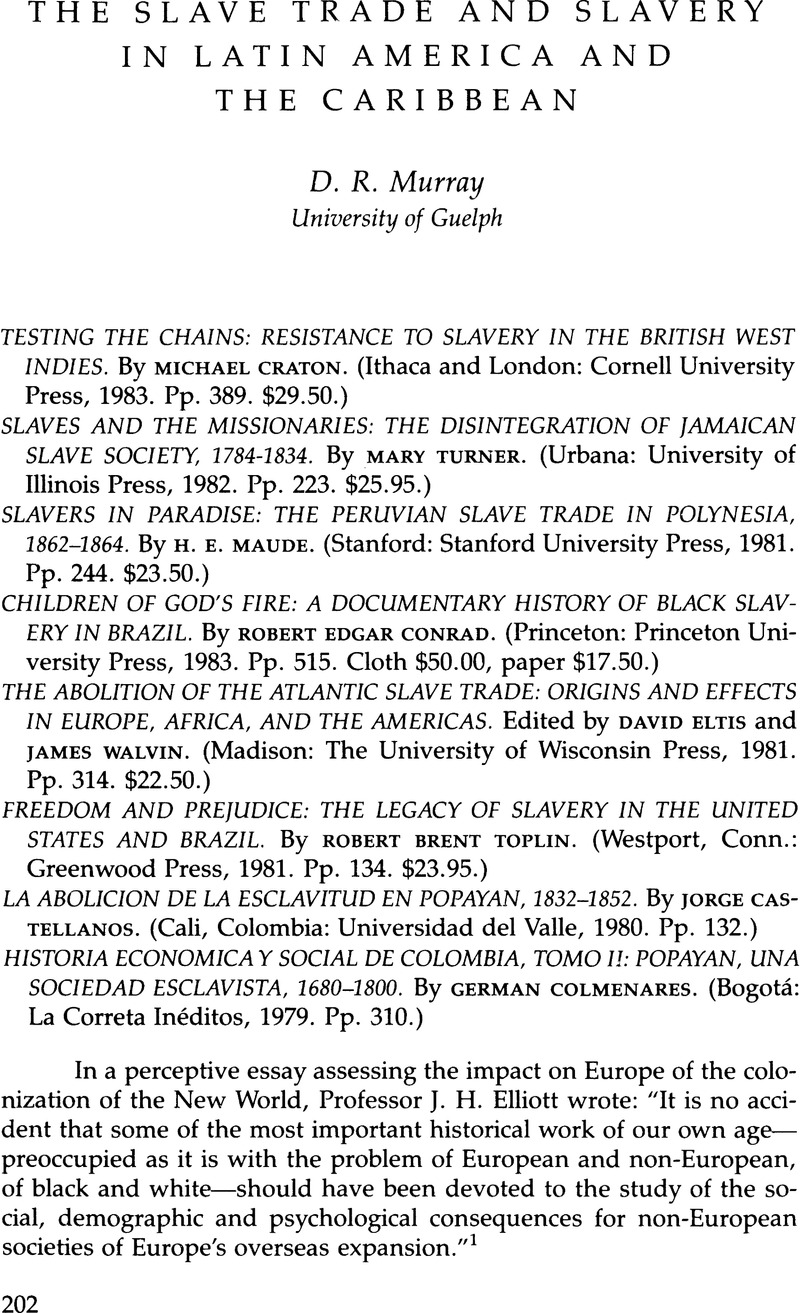No CrossRef data available.
Published online by Cambridge University Press: 12 October 2022

1. J. H. Elliott, The Old World and the New, 1492-1650 (Cambridge: Cambridge University Press, 1970), 4.
2. M. Craton, “The Passion to Exist: Slave Rebellions in the British West Indies, 1650-1832,” Journal of Caribbean History 13 (Summer 1980):1-20; and Sinews of Empire: A Short History of British Slavery (Garden City, N.Y.: Anchor, 1974), 226-37. See also H. Orlando Patterson, “Slavery and Slave Revolts: A Socio-Historical Analysis of the First Maroon War, Jamaica, 1655-1740,” Social and Economic Studies 19 (1970):289-335; and The Sociology of Slavery (London: MacGibbon & Kee, 1967), 260-83.
3. D. B. Davis, The Problem of Slavery in the Age of Revolution, 1770-1823 (Ithaca: Cornell University Press, 1975), 71.
4. Mary Reckford, “The Jamaica Slave Rebellion of 1831,” Past and Present 40 (July 1968):108-25.
5. See, for example, John W. Blassingame, Slave Testimony: Two Centuries of Letters, Speeches, Interviews, and Autobiographies (Baton Rouge: Louisiana State University Press, 1977).
6. A. J. R. Russell-Wood, The Black Man in Slavery and Freedom in Colonial Brazil (New York: St. Martin's Press, 1982), 104-27.
7. Ibid.
8. Thomas Skidmore, “Toward a Comparative Analysis of Race Relations since Abolition in Brazil and the United States,” Journal of Latin American Studies 4, no. 1 (1971):1-28.
9. Manuel Moreno Fraginals, El ingenio: complejo económico social cubano del azúcar (Havana: Editorial de Ciencias Sociales, 1978). See also Franklin Knight, “The Caribbean Sugar Industry and Slavery,” LARR 18, no. 2 (1983):219-29 for a review of El ingenio.
10. Magnus Mörner, “Recent Research on Negro Slavery and Abolition in Latin America,” LARR 13, no. 2 (1978):266.
11. For a fuller description of the British slave trade during this period, see Colin A. Palmer, Human Cargoes: The British Slave Trade to Spanish America, 1700-1739 (Chicago: University of Illinois Press, 1981).
12. See especially Robert W. Fogel and Stanley Engerman, Time on the Cross: The Economics of American Slavery, 2 vols. (New York: Little, Brown, 1974); and William F. Sharp, “The Profitability of Slavery in the Colombian Chocó, 1680-1810,” Hispanic American Historical Review 55, no. 3 (Aug. 1975):468-95.
13. John V. Lombardi, The Decline and Abolition of Negro Slavery in Venezuela, 1820-1854 (Westport, Conn.: Greenwood Press, 1971), 68.
14. See Rebecca J. Scott, “Explaining Abolition: Contradiction, Adaptation, and Challenge in Cuban Slave Society, 1860-1886,” Comparative Studies in Society and History 26, no. 1 (Jan. 1984):83-111; and her article “Gradual Abolition and the Dynamics of Slave Emancipation in Cuba, 1868-86,” Hispanic American Historical Review 63, no. 3 (1983):449-77. See also her forthcoming book, Slave Emancipation in Cuba: The Transition to Free Labor (Princeton: Princeton University Press).
15. Manuel Moreno Fraginals, El ingenio.